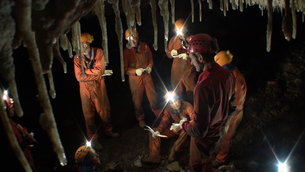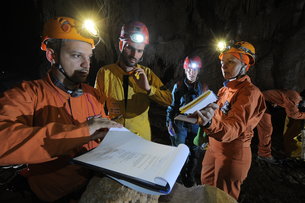25.09.2019

WHAT IS CAVES?
CAVES stands for Cooperative Adventure for Valuing and Exercising human behaviour and performance Skills. The three-week course prepares astronauts to work safely and effectively in multicultural teams in an environment where safety is critical – in caves.
CAVES teaches astronauts to explore underground systems as a team, delving deep underground to perform scientific experiments as well as chart and document their activities.
Participants must adapt to living and working together in a unique environment to meet scientific and exploration objectives. Constant attention to safety rules, procedures and equipment is critical to the successful completion of the mission.
The course is run by the European Space Agency to simulate spaceflight. Seasoned International Space Station astronauts as well as rookies participate in the course and share experiences.
Before entering the cave, trainees attend an eight-day mix of classroom and basic caving lessons. They receive technical lectures on topics such as exploration, communication, emergency procedures and the science of speleology.
Behavioural training
CAVES presents the astronauts with environments and situations very similar to spaceflight, to help them transfer the learning from their caving expedition to space.
The cave environment provides many space-relevant conditions, including isolation from the outside world, confinement, minimal privacy, technical challenges, and limited equipment and supplies for hygiene and comfort.
Behavioural activities are woven into the course to foster effective communication, decision-making, problem-solving, leadership and team dynamics.
The daily routine is organised around timelines and activity lists. Each day a new cave is visited by the crew where they face new challenges to apply their caving skills. Obstacles, cave mapping, photography and scientific sampling are part of the training.
An important element of the expedition is the daily debriefing, which reflects on the successes and errors of the day, on similarities with spaceflight experiences and on how to reapply successful strategies or improve by learning from mistakes.
Learning is enhanced by the presence of experienced astronauts, who share their valuable flight experience with rookies.
Quelle: ESA
+++
Into the deep

There is never a dull day for participants of the CAVES campaign, ESA’s field training adventure that hones the communication, problem solving and teamwork skills an international crew will need to explore the tough, uncharted terrain of the Moon and Mars.
This week six astronauts turned ‘cavenauts’ from five space agencies headed underground in Slovenia, where they are currently living and working for the week. To keep the element of exploration, astronauts themselves do not know the exact location.
The goal is to run scientific experiments while managing the psychological toll of being in an extreme environment with a multinational crew.
Following a week’s training above ground, including lectures from experts and practical exercises, the team is now underground searching for signs of life that have adapted to the extreme conditions in the caves.
One of the team’s main scientific objectives is to follow the water, a vital resource on- and off- our planet.
Caves are usually formed by running water and ESA picked a cave where rivers flow underground for this training expedition. For the first time, the team will be on the lookout for microplastics. They will also test water chemistry and learn to find and interpret waterways in a cave system.
Trainees are also sampling and analysing microbes that have managed to survive in such inhospitable conditions. Geochemistry, meteorology and other environmental studies are on the list. Read more about the science happening beneath the surface.
If it sounds like a lot to ask of astronauts in a two-week period, fear not. The cavenauts are well prepared and supported.
The astronauts are also using an upgraded version of the Electronic Field Book. This all-in-one, easy-to-use application will allow them to deliver science and video logs while checking procedures and cue cards on a tablet.
Above ground, mission control will track their progress with a 3D map generated on the app as they explore the cave. Scientists can locate the astronauts’ scientific observations paired with pictures, and send their comments back to the cave.
The six cavenauts of this edition of CAVES are ESA astronaut Alexander Gerst, NASA astronauts Joe Acaba and Jeanette Epps, Roscosmos’ cosmonaut Nikolai Chub, Canadian Space Agency astronaut Josh Kutryk and JAXA’s Takuya Onishi. Chub and Gerst are serving as co-commanders of the expedition.
Quelle: ESA


